Menus
- The black lightning
- Phil Irving – the brilliant designer
- Australian speed record under fire
- The Ehret-Vincent remains unrestored
- Brakes were probably not an issue back then …
- Comparison drive with the replica
- Technical specifications
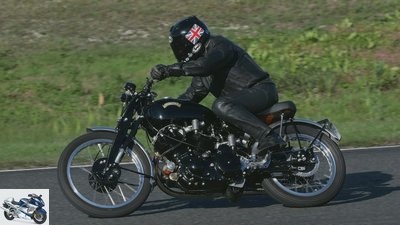
Kel Edge
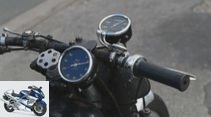
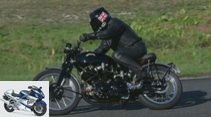

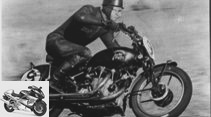
11 photos

Kel Edge
1/11
With this Vincent Black Lightning, still unrestored today, racing driver Jack Ehret once broke the Australian speed record. To be able to do a few laps with her and a perfect replica is a great honor for us.
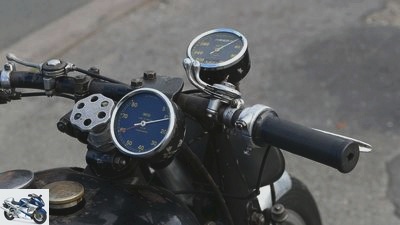
Kel Edge
2/11
The cleanly drawn Smiths watches exaggerate: the tachometer scale shouldn’t be used, the speedometer scale up to 300 km / h cannot be reached with the 70 hp of the Vincent
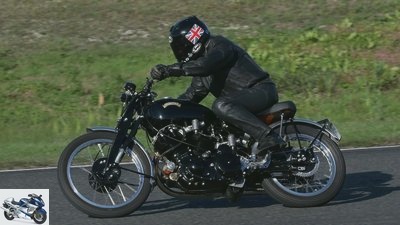
Kel Edge
3/11
Only when you let it run properly at high speed,
the chassis is in its element. The Vincent completes slow curves rather slowly
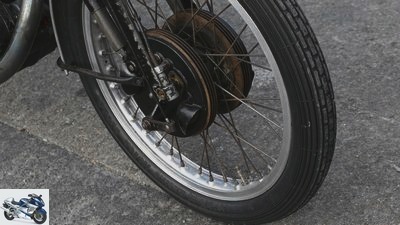
Kel Edge
4/11
Even the double pack is of little help here: With the 178 millimeter simplex drum brakes, there is nothing to be said for it. They are hardly up to the high performance
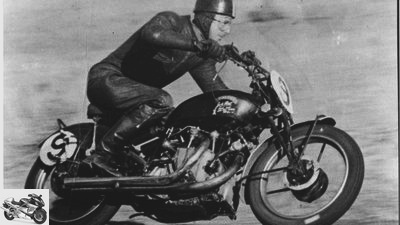
Kel Edge
5/11
Always fast – whether solo or with a team: Ehret managed to set Geoff Duke’s lap record in the 1955 Mount Druitt race
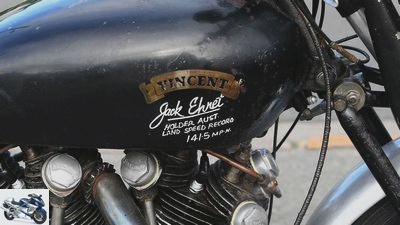
Kel Edge
6/11
It’s not just the inscription on the tank that says it, …
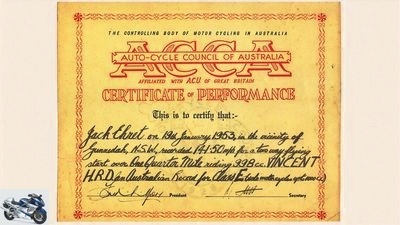
Kel Edge
7/11
… The official certificate also shows Jack Ehret and his Vincent as the record holder. Just four months later, however, the record was narrowly trumped by Harry Gibson

Kel Edge
8/11
Ugh outside, hui inside? Not really. Although the interior of the engine has been almost completely renewed by Patrick Godet, the unadulterated original look makes the aged Vincent really authentic
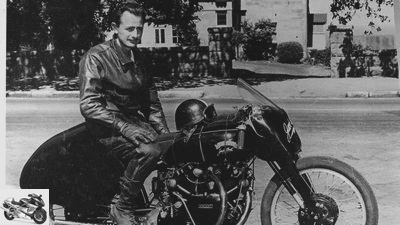
Kel Edge
9/11
Jack Ehret poses for the official photo before his big trip: In January 1953 he set a new Australian speed record of 141.509 mph (227.9 kmh)

Kel Edge
10/11
Original and authentic replica: on the left the current owner Nicolas Dourassoff with the ex-Jack Ehret-Vincent, on the right the Vincent specialist Patrick Godet with the perfect replica down to the last detail

Kel Edge
11/11
Jack Ehret, sometimes solo, sometimes with a sidecar in the team class at the start. Like here at the Mount Druitt race in 1953, with lubricant
Stan Blundell on board
Unrestored Vincent Black Lightning
The black lightning
Content of
With this Vincent Black Lightning, still unrestored today, racing driver Jack Ehret once broke the Australian speed record. To be able to do a few laps with her and a perfect replica is a great honor for us.
E.To be charged, to drive what will probably be the last one hundred percent original copy of what is probably the most desirable production motorcycle of all time, is certainly both an honor and a duty. The honor of being given a historic, unrestored, 66-year-old bike in a class of its own and the duty to bring it back intact to its generous owner Nicolas Dourassoff. Because the 1951 Vincent Black Lightning, once owned by racing and record driver Jack Ehret, is nothing less than living history on two wheels.
Buy complete article
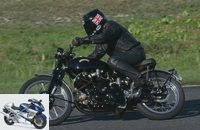
Unrestored Vincent Black Lightning
The black lightning
Vincent Black Lightning was ready to drive and he also brought an absolutely authentic Black Lightning replica that he built for another customer, the Englishman Peter Fox. The Vincents have always been known for their fabulous performance. More than six decades ago, when the Black Shadow was able to boast that it was the fastest mass-produced vehicle available.
Phil Irving – the brilliant designer
The glorious company history began back in 1928: The Cambridge graduate Philip Vincent acquired the now extinct company HRD with the financial help of his father. After the early Bantam models, a delivery three-wheeler with a 293 cc single-cylinder engine, and the 500cc single models Comet and Meteor from 1934, the brilliant designer Phil Irving created the first 1000cc engine in 1936. The V2 with the unusual cylinder angle of 47.5 degrees developed 45 hp and was used in the Vincent Rapide Series A models. Only 78 copies were made before the outbreak of World War II, but the 50-degree V2, which was modernized and redesigned for the post-war era, started again as a Series B in the Standard Rapide from 1946. The ultimate Vincent, however, was to be the Series C Black Lightning, a production offshoot of the bike that Rollie Free used to set the world speed record on the Bonneville Salt Flats in Utah in 1948. Only wearing swimming trunks and lying stretched out on the bike, Free had set the new record at 241.905 km / h. The spectacular pictures of this daredevil drive still cause amazed faces today.
At the Earls Court Show in London, which was then just revived, the Series C Black Lightning was presented in November 1948, with a self-made “Girdraulic” trapezoidal fork and cantilever steel swing arm with a Vincent hydraulic damper and two separate springs. The Vincent Black Lightning caused a sensation, also because of its astronomical price of 400 pounds (plus 108 pounds income tax). It is generally accepted that only 33 complete customer versions – all Series C models except for a Series D model – were built. Today it is perhaps the most desirable motorcycle ever produced, and all but one are said to still exist.
Australian speed record under fire
Tony McAlpine used one of the eight machines shipped to Australia very successfully in races – the dazzling figure of the Australian racing scene crossed the finish line as the winner in twelve of thirteen competitions that had started. McAlpine decided to get involved in the European racing circuit in the 1951 season and secured a 350 AJS for this. However, between races he worked at the Vincent factory in Stevenage, and with their kind permission he built his new Vincent Black Lightning himself with engine number F10AB / 1C / 7305 and frame number RC9205. On June 5, 1951, the machine was ready , in July she did a quick test run that turned out to be hellishly quick. On his return to Australia and with other plans in mind, McAlpine decided to offer the new Vincent he had brought with him, which had still not yet completed a race, for sale for a proud £ 500.
One of the few who were liquid enough to buy the Vincent Black Lightning was the car dealer Jack Forrest. The ambitious pilot, however, lost control in a race and crashed into a fence. The Vincent had suffered only slight superficial damage, but Forrest’s love for her seemed to have died as a result. So he put the Lightning up for sale at the same price of 500 pounds, and now it was to come into the hands of Jack Ehret, who ran two motorcycle shops at the time and was already Vincent experienced. Ehret knew that if he didn’t buy it, a competitor would take it. So No. 7305 found a new home with him, where she was to stay for the next 47 years.
At that time, the Australian speed record was constantly under attack, usually by Vincent drivers, and so Ehret also dared to break Les Warton’s record of 122.6 mph on a remote stretch between Gunnedah and Tamworth in January 1953. Despite constant little problems, such as a broken gear lever on the first run, in which he achieved a phenomenal 149.6 mph in one direction, Ehret finally set a new record with an officially measured average of 141.509 mph (226.4 km / h) put up. In the following years his Vincent Black Lightning, with or without a sidecar, became a fixture in Australian racing. But Jack turned to other businesses and finally sold the racing bike in 1999, two years before he died unexpectedly at the age of 78.
The Ehret-Vincent remains unrestored
Fortunately, the new owner of the Vincent Black Lightning, Franc Trento, decided not to restore the bike, but to leave it in a used condition. In 2014 Trento finally sold the Vincent to the French collector Nicolas Dourassoff, who took it to France, where the Vincent specialist Patrick Godet carefully restored it to a driving and racing condition.
In 66 years the Vincent Black Lightning had covered 8,587 kilometers – the “European” kilometer speedometer was installed from the start. And according to Dourassoff, she is not yet ready to spend her retirement years in the museum. Rather, I now have the opportunity and the honor to ride the bike with its glorious history and slightly increase the mileage to 8682. Thanks to the excellent work of Godet. “From the outside it looks old and used, but the innards are almost entirely new,” he explains. “The engine parts were badly worn, the crankshaft repaired in a strange way. We made all the parts from the original drawings. We have also converted the V2 to run on petrol instead of methanol. ”The crankcases that were visibly used remained original, in contrast to the more modern magnesium replicas on Peter Fox’s replica.
The rear wheel, however, is no longer original: the original 20-inch model has been replaced by a 19-inch wheel – simply because there are no more 20-inch racing tires. All the weight-saving parts made of aluminum or magnesium (parts of the brakes, rims, fenders, etc.) contribute to the significantly reduced weight of the Black Lightning: While the more civil Black Shadow weighed 208 kilograms dry, the Black Lightning with its 172 is downright feather-light. The racing components and numerous modifications ensure the increase in performance from the 55 hp of the Black Shadow to the aforementioned 70 of the Lightning: Mark II camshafts with performance-enhancing timing, polished flywheels and specialloid pistons are used for the high compression of 13: 1 worries. In addition, all flow-relevant areas are polished and the mixture preparation is carried out by 32 Amal carburettors. The exhaust gases are discharged through two inch (approx. 50 mm) exhaust pipes.
Brakes were probably not an issue back then …
So much for the technical history. So now I’m on the Carole race course with his Mickey Mouse infield and am amazed at how well the unrestored Vincent Black Lightning is doing here. Especially in the tight turns, where most racing bikes have to try first gear. Not so with Vincent. Thanks to the massive torque reserves, a short throttle and sensitive use of the smooth clutch lever are enough to let the machine shoot forward as if snapped by a rubber band. Accompanied by the thundering sound from the two continuous exhaust pipes. In this way, I literally fly past the modern Yamaha R6 and 600 series Hondas, which have thrown me off in the infield and also humiliate me again and again when braking before the corners. While I start to slow down what feels like miles before the next hairpin bend, the others here seem to be just shifting into top gear. The brakes are definitely the worst thing about the Vincent Black Lightning. The double 178-millimeter drum brakes at the front and rear not only decelerate poorly, they also decrease in effectiveness with each braking. Brakes were hardly an issue back then.
Top speed on the straight seems to have been so much in focus that nobody was bothered by the extremely cumbersome gearbox. The exhaust pipes are so close under the right footrest that it is extremely difficult to get your right foot under the notch to downshift.
Comparison drive with the replica
The same problem exists with the replica by Peter Fox, which I can move immediately afterwards for comparison. In return, the replica engine confirms the impression of the performance development of the Ehret bike: full thrust from the very bottom, a real jolt goes through the bike from 3,800 rpm, from here energetic power that can be used in the race begins. In no time at all, the tachometer needle has reached the 6,000 mark, which warns you to shift gear immediately. With all the thrust that the Vincent Black Lightning offers – in view of the fabulous performance it looks rather narrow and low and not as huge as one might expect from a 240 km / h superbike. The flat, rather narrow handlebars allow a sufficiently comfortable riding posture that is bent forward and is also suitable for fast, extended stages. In terms of handling in slow, tight corners, the Black Lightning proves to be rather clumsy, and the Girdraulic fork seems to want to constantly fold into the curve. That changes with increasing speed – a forced driving style is rewarded with increasingly better steering precision and more predictable lines. For the conditions at the time, the chassis qualities offered can be regarded as excellent, not least thanks to the perfectly functioning rear suspension. And the output of the V2 engine, which is still impressive today, must one day have overwhelmed the pilots. After all, there was nothing like it in the 1950s.
The ex-Jack Ehret-Vincent Black Lightning is not only an extremely desirable collector’s item, but also provides a reliable impression of the extraordinary performance that Philip Vincent’s motorcycles offered over 60 years ago. How good that the new owner rides and enjoys this bike instead of locking it up as a technical work of art in a museum.
Technical specifications
Vincent Black Lightning
- engine: Air-cooled two-cylinder four-stroke 50-degree V-engine, two half-height camshafts, two valves per combustion chamber, actuated via bumpers and rocker arms, two 32 mm Amal carburettors, bore x stroke: 84 x 90 mm, displacement 998 cm³, compression 13: 1, output 70 hp at 5,600 rpm
- Power transmission: Ferodo single-disc dry clutch, four-speed gearbox, chain drive
- landing gear: Sheet metal profile subframe, engine integrated as a load-bearing element, trapezoidal fork with hydraulic damping at the front, cantilever steel swing arm with hydraulic damper and two separate springs, wire-spoke wheels with aluminum rims, tires front 3.00-21, rear 3.50-19, two 178 mm simplexes each -Drum brakes front and rear
- mass and weight: Wheelbase 1,435 mm, dry weight 172 kg, tank capacity 17 l
- Mileage: Top speed 226 km / h
- Construction year: 1951
- New price (1951): 508 Brit. Pound (approx. 5,940 marks)
Related articles
-
Vincent Black Lightning Record Auction
Bonhams 6 pictures Bonhams 1/6 An extremely rare Vincent Black Lighning was auctioned at the Bonhams auction house. Bonhams 2/6 From this model …
-
Auction Vincent Black Shadow HRD 1000 Series D
Catawiki 8 images Catawiki 1/8 This Vincent Black Shadow HRD 1000 Series D is currently being auctioned at Catawiki. Estimate: 110,000 to 145,000 euros ….
-
On the move: Vincent Black Prince and White Shadow
Paulovits 19th photos Paulovits 1/19 There are motorbikes that chase you for a lifetime. This definitely includes Vincent’s motorcycles. Paulovits 2/19…
-
Nakamura 11 photos Nakamura 1/11 And the innovations are worthwhile. The Black Shadow is easy to control on the road. Here Alan Cathcart pounds across…
-
On the move: Vincent Black Shadow
Nakamura On the move: Vincent Black Shadow The last of its kind Content of In 2007 the last Black Shadow of the Series C went under the hammer at the…
-
Endurance test final balance Buell Lightning XB12S
Bilski endurance test final balance Buell Lightning XB12S Prima Donner This is how they are, the Buells: capricious like prima donnas. But the dull rumble of the XB12S …
-
35 photos 1/35 Photo gallery: Triumph Bonneville T100 Black, Moto Guzzi V9 Roamer and Harley-Davidson Sportster 883 Iron in a…
-
Comparison test two-cylinder: BMW R 1200 R, Buell Lightning XB12Ss and Moto Guzzi Griso 8V
fact comparison test two-cylinder: BMW R 1200 R, Buell Lightning XB12Ss and Moto Guzzi Griso 8V Big Twins only 1170, 1202, 1151 ?? these…
-
fact Buell Lightning XB12S review Evolution theory Buell is now finally leaving the ecological niche of the harmless exotic. The active XB12S poaching in…
-
Buell S1 Lightning Strike review
Buell S1 Lightning Strike review Spoiled for choice The new Buell S1 Lightning Strike is available in eleven different color combinations. And because…